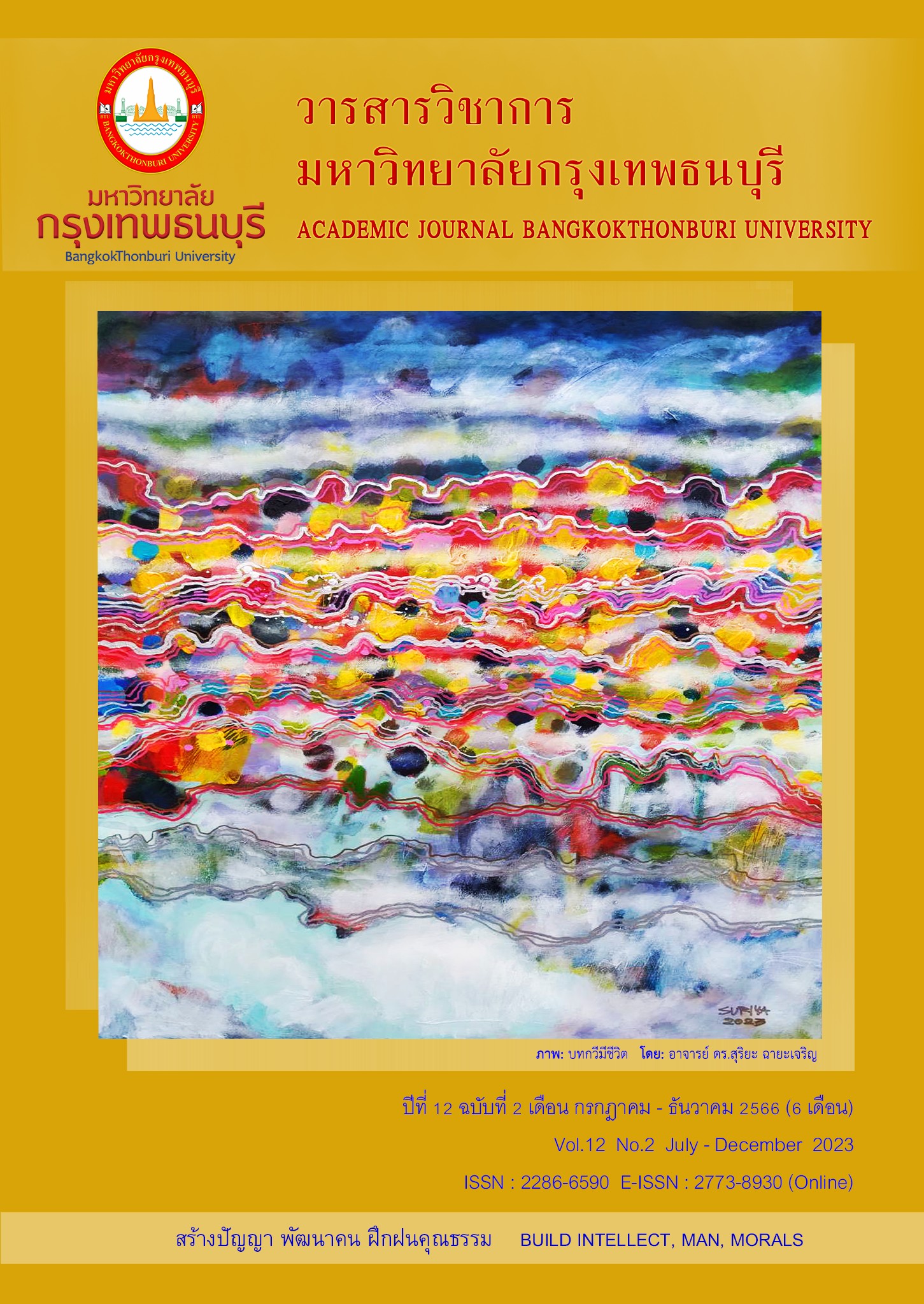Model Causal Relationship of Factors Affecting Loyalty Group Business Food and Beverage in Thailand
Main Article Content
Abstract
The objectives of this research: 1) to study the direct influence indirect influence and overall influence 2) to analyze the causal relationship of factors influencing the Loyalty group business food and beverage in Thailand 3) to develop a structural equation model of variables influencing the Loyalty group business food and beverage in Thailand.
This research is a mixed research. The quantitative research used the method to determine the sample size according to the criteria of Hare et al. from the population of 1,435, which the sample group consisted of 300 entrepreneurs. and qualitative research. A random sampling method was used for 15 participants, including Loyalty group business food and beverage in Thailand and marketing. The instrument used for data collection was a questionnaire. The statistics used in this research were percentage, mean, standard deviation and structural equation model analysis by Semi-Structural Equation Modeling (SEM).
Major findings: (1) social responsibility service quality confidence and satisfaction Directly and indirectly influence the loyalty of food and beverage business groups in Thailand the model coherence index (χ2/df=0.53, RMSEA=0.00, GFI=0.99, AGFI=0.97, RMR=0.00, SRMR=0.00, NFI=0.99, CFI=1.00. (2) factors affecting the loyalty of food and beverage business groups in Thailand were social responsibility. service quality confidence and satisfaction and (3) the fidelity of the model. Food and beverage business group There is a mutual link with social responsibility. service quality confidence and satisfaction.
Article Details

This work is licensed under a Creative Commons Attribution-NonCommercial-NoDerivatives 4.0 International License.
References
กรมพัฒนาธุรกิจการค้า กระทรวงพาณิชย์. (2565). ระบบคลังข้อมูลธุรกิจ. สืบค้นวันที่ 5 มกราคม 2563. จาก http://datawarehouse.dbd.go.th/bdw/search/search2.html.
ณัฐพัชร์ ล้อประดิษฐ์พงษ์. (2560). คู่มือสำรวจความพึงพอใจลูกค้า. กรุงเทพมหานคร: ประชุมทอง พริ้นติ้งกรุ๊ป.
ศศิประภา ชัยประสิทธิ์. (2561). องค์กรนวัตกรรมทางเลือกของผู้ประกอบการยุคใหม่. วารสารนักบริหาร, 30(2), 60-69.
สถาบันพัฒนาธุรกิจอย่างยั่งยืน. (2558). ความรับผิดชอบต่อสังคมเพื่อความยั่งยืนขององค์กร. (CSR- for-Corporate Sustainability). (พิมพ์ครั้งที่ 2). กรุงเทพฯ: สถาบันธุรกิจเพื่อสังคมและสถาบันพัฒนาธุรกิจอย่างยั่งยืน.
สํานักงานคณะกรรมการพัฒนาการเศรษฐกิจและสังคมแห่งชาติ. (2564). แผนพัฒนาเศรษฐกิจและ สังคมแห่งชาติ ฉบับที่ 12 พ.ศ. 2560-2564. สืบค้น 15 ธันวาคม 2566 จาก www.ratchakitcha.soc. go.th/DATA/PDF/2559/A/115/1.PDF.
สํานักงานส่งเสริมวิสาหกิจขนาดกลางและขนาดย่อม. (2557). รายงานสถานการณ์วิสาหกิจขนาดกลางเเละขนาดย่อม ปี 2557. กรุงเทพ: สํานักงานส่งเสริมวิสาหกิจขนาดกลางและขนาดย่อม.
Amin, M. & Fontaine, R. (2013). Islamic Banks: Contrasting the Drivers of Customer Satisfaction on Image, Trust, and Loyalty of Muslim and Non-Muslim Customers in Malasia. International Journal of Bank Marketing, 31(2), 79-97.
Amin, M., Isa, Z. & Fontaine, R. (2013). Islamic banks: contrasting the drivers of customer satisfaction on image, trust, and loyalty of Muslim on non-Muslim customers in Malaysia. The international journal of bank marketing, 31(2), 79-97.
Bloomer, R. J., Larson, D. E., Fisher-Wellman, K. H., Galpin, A. J. & Schilling, B. K. (1999). Effect of eicosapentaenoic and docosahexaenoic acid on resting and exercise-induced inflammatory and oxidative stress biomarkers: a randomized, placebo controlled, cross- over study. Lipids in health and disease, 8(36), 1-12.
Butt, M.M. and Aftab, M. (2012). Incorporating attitude towards Halal banking in an integrated service quality, satisfaction, trust and loyalty model in online Islamic banking contex. The international journal of bank marketing, 31(1), 6-23.
Choi, B. & La, S. (2013). The impact of corporate social responsibility (CSR) and customer trust on the restoration of loyalty after service failure and recovery. Journal of Services Marketing, 27(3), 223-233. DOI: 10.1108/08876041311330717.
Fatma, M. & Rahman, Z. & Khan, I. (2015). Building company reputation and brand equity through CSR: the mediating role of trust. International Journal of Bank Marketing, 33(6), 840-856. DOI: 10.1108/IJBM-11-2014-0166.
Kotler, P. (1997). Marketing management: analysis, planning, implementation and control. (5th. ed.). Englewood Cliffs, NJ: Prentice Hall.
Lau, M. M., Lam, A. Y. & Cheung, R. (2016). Examining the Factors Influencing Purchase Intention of Smartphones in Hong Kong. Contemporary Management Research, 12, 213-224.
Ngoc Phan, K. & Ghantous, N. (2013). Managing brand associations to drive customers’ trust and loyalty in Vietnamese banking. International Journal of Bank Marketing, 31(6), 456-480. https://doi.org/10.1108/IJBM-04-2013-0038.
Nyhan, R. C. & Marlowe, H. A. (1997). Psychometric Properties of the Organizational Trust Inventory. Evaluation Review, 21, 614-635. https://doi.org/10.1177/0193841X9702100505.
Parasuraman, A. P., Zeithaml, V. A. & Berry, L. L. (1985). A Conceptual Model of Service Quality and its Implication for Future Research (SERVQUAL). Journal of Marketing, 49, 41-50.
Sánchez-Franco, M. J. (2009). The Moderating effects of involvement on the relationships between satisfaction, trust and commitment in e-banking. Journal of Interactive Marketing, 23(3), 247-258.
Seiler, S., Jøranson, K., Olesen, B. V. & Hetlelid, K. J. (2013). Adaptations to aerobic interval training: interactive effects of exercise intensity and total work durationScandinavian. Journal of Medicine & Science in Sports, 23(1),74-83.


